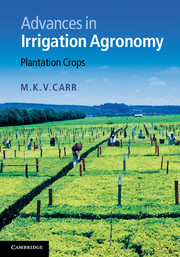9 - Sugar cane
Published online by Cambridge University Press: 05 May 2012
Summary
Introduction
Sugar cane (Saccharum officinarum L., the so-called Noble Cane because of its fine thick stem) is believed to have originated in the islands of the South Pacific, probably New Guinea (2–10° S) having evolved through human selection from strains of two wild species S. robustum and S. spontaneum and hybridisation with S. sinense (Purseglove, 1972; Bull and Glasziou, 1976; Julien et al., 1989; Jones et al., 1990; Simmonds, 1998). Because of its natural sweetness, it has been grown for chewing since ancient times in the Pacific and South-east Asia. The production of sugar from sugar cane began in India, followed by China, Persia (Iran), Egypt and Spain and elsewhere around the Mediterranean. In the seventeenth century the first plantations were established in the West Indies, and the resultant need for labour, particularly for harvesting, led to sugar cane's links with the slave trade.
Most of the commerce between Europe and the sugar regions of the west that followed was subsequently based on the outward shipment of slaves and the homeward carriage of sugar, molasses and rum (Purseglove, 1972; Hobhouse, 1985). Molasses, the dark brown viscous liquid residue left behind after the centrifugal process has ended and no more sucrose can be extracted, is one of the most important by-products (contains 50% fermentable sugars) from the manufacture of cane sugar. It is used as a raw material in industry. Rum is produced by the fermentation of molasses, followed by distillation. Other products include industrial ethyl alcohol (ethanol), which is manufactured from molasses, and bagasse, the fibrous residue left after the extraction of juice from the cane (used for fuel in the sugar factory, as well as in various manufacturing processes). The pith from the bagasse is used as a stockfeed. Not much of the plant is wasted.
- Type
- Chapter
- Information
- Advances in Irrigation AgronomyPlantation Crops, pp. 195 - 221Publisher: Cambridge University PressPrint publication year: 2012

